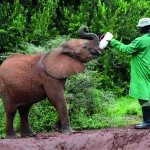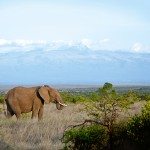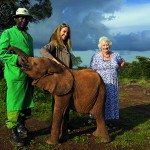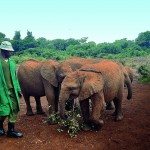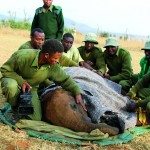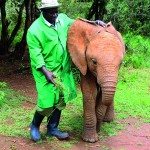When tiny Kithaka arrived at the elephant orphanage in Nairobi two years ago, he was less than a week old, the hind side of his ears still soft and petal pink.
Kithaka was airlifted from near the village he’d wandered into looking for company and has survived against all odds. He is one of the lucky ones and lives with 28 other orphaned baby elephants at the David Sheldrick Wildlife Trust nursery in Nairobi National Park.
When I met him and the other young elephants, the keepers laughed when Kithaka whacked me with his trunk a few times and gambolled around me with a mischievous glint in his eye. They expected nothing less from this fun-loving, if not a little naughty, member of the herd.
Sadly, almost all the orphans’ mothers have been killed by poachers. Elephants are known to grieve the loss of loved ones deeply; families are as important to them as they are to humans. They form family units that last their whole lives (60-70 years), and although baby elephants can start grazing from four months, they drink their mother’s milk until they are five years old.
When an orphan first arrives at the nursery, they are usually severely emaciated and only an IV drip infusion can save them. Not all the rescued elephants survive – last year, 27 elephants died despite round-the-clock care. The trauma of losing their mothers, combined with the terror of being left all alone and then captured, means many simply lose the will to live. Those who do survive learn to form new family bonds with other orphans and keepers and are as playful as any group of young children.
At feeding time, keepers hold up giant bottles of milk for them to drink and the elephants guzzle it down at speed. Some curl their trunks around the bottles and grip on to them; the smaller ones need more help. Afterwards, they lock trunks and push one another around, roll on the ground, or munch contentedly on tree branches.
Head keeper Edwin Lusichi has been working at the nursery for the past 15 years. He initially studied computer science but couldn’t find work in his field.
“In the first place I was just in need of a job. Now, it’s beyond a job – it’s a passion as well,” Lusichi says. The keepers sleep alongside the elephants on raised platforms in the elephants’ straw-floored “bedrooms”.
“They are still young and can easily get pneumonia as well, so they need someone to cover them with a blanket when they lie down,” Lusichi explains. “They have lost their families so they are stressed and lonely; they need somebody to keep them company. Emotionally, elephants are just like humans.”
New orphans are welcomed with excitement by the other elephants. The females, driven by their maternal instincts, rush to comfort a newcomer, laying a trunk over them in a tender gesture. Older orphans feel the pain of losing their families most acutely, so the other elephants give them the space they need to mourn.
Keepers and their elephants develop a close bond. They spend their days playing, walking and eating together and if anything scares an orphan, they will run to their keepers for protection.
“What I love is how intelligent and clever they are, how special they are, how able they are to understand you and what you want, and respond,” Lusichi says.
Living legacy
Dr Dame Daphne Sheldrick founded the David Sheldrick Wildlife Trust in honour of her late husband who had spent 30 years as the founding game warden of Tsavo National Park, now Kenya’s largest wildlife refuge. She worked alongside the conservationist for 25 years and, after his death in 1977, spent the next 10 years continuing his work to save wildlife habitats from her new base in Nairobi National Park.
Only when the Kenya Wildlife Trust approached her to help save two orphaned elephants did the Orphans’ Project begin – Daphne had the nutrition and husbandry expertise essential for the elephants to survive. Still, it took 28 years to perfect the milk formula the elephants needed.
When orphans are taken to Tsavo National Park for release into the wild at around three years old, their keepers have mixed feelings about it.
“We miss them because they are going away from us, but we want them to go because we have rescued them while they are still young and the reason we have rescued them is to save them and set them free,” Lusichi says.
The elephants are slowly transitioned back into the wild, with another set of keepers taking care of them until they are adopted into a herd, a process that can take years. So far, around 160 elephants have been hand-raised and released, making the Wildlife Trust the most successful orphan elephant rescue and rehabilitation programme in the world. It is also a leading conservation organisation for wildlife and habitat protection in East Africa.
Now led by David and Daphne Sheldrick’s daughter, Angela, the Wildlife Trust operates eight anti-poaching and de-snaring units to protect 60,000 square kilometres of elephant habitat, as well as four mobile veterinary units to alleviate the suffering of injured wild animals in Tsavo and several reserves. Angela has grown up with elephants, as have her two sons.
“I would be lying if I said there hadn’t been a few special treasures,” she laughs.
“It’s funny, I always find the males are the more affectionate and loving ones and it’s of course the gentle lovingness that you just can’t resist. We have some very mischievous ones, too, and just through their sheer naughtiness it makes them terribly appealing.”
Research shows humans respond positively to the low frequency infrasound elephants use to communicate, says Angela.
“You cannot be around elephants without feeling that brush of magic. Our keepers are the happiest dudes you can imagine … we have zero turnover; some have been here for 26 years,” she says.
Fighting the ivory trade
As heartwarming as it is to see elephants being given a second chance at life, that the orphanage has to exist at all is the real tragedy. Ivory poachers are killing elephants at a rate of one every 15 minutes and unless there’s an enforced global ban on all ivory trade, elephants in the wild could be wiped out within 10 years.
When poachers shoot, spear or poison elephant mothers, their calves are left to fend for themselves until they starve or become prey for predators looking for a meal. Kenya once had an elephant population of more than 167,000, but numbers have dwindled to around 30,000 today. Population sprawl and habitat destruction is partly responsible for this decline, but poaching is by far the greatest threat to elephants’ survival.
Despite a worldwide ban in the trade of ivory in 1989, large-scale shipments in excess of 800kg of ivory have more than doubled since 2009, when the Convention on International Trade in Endangered Species of Wild Fauna and Flora sanctioned the sale of 102 stockpiled tonnes of legal ivory from Southern Africa to China and Japan. By flooding the market with legal ivory, the thinking was that it would undermine the black market. Instead, the authorised sales had the opposite effect.
“That opened the floodgates and that’s when poaching started all over again,” Angela says. “What that does is fuel the thirst for ivory and illegal ivory finds its way through the legal channels … It’s so obvious that’s what was going to happen. That was a cataclysmic mistake and of course they were forewarned and nobody listened. It was very upsetting.”
Only destroying stockpiles and banning the sale, import and transport of ivory products will have the impact needed to buy the time required to educate communities about the importance of protecting this beautiful and intelligent animal.
The Orphans’ Project has attracted donor support from around the world through its fostering programme. For US$50 a year you can adopt an elephant and become part of the Wildlife Trust’s online community.
“We are so grateful,” Angela says. “We are mindful that none of what we have achieved would be possible without this global support. It’s a monetary support but it’s also the support and energy that’s out there that will ultimately force change.”
Visit sheldrickwildlifetrust.org to adopt an elephant of your own.
Taking action
Through its “iworry” campaign, the David Sheldrick Wildlife Trust is calling on governments to impose and enforce a ban on all sales of ivory and to destroy all stockpiles.
The US banned commercial trade in ivory in February 2014 and committed US$10 million to help Africa fight poaching, while France recently destroyed three tonnes of illegal ivory with a street value of about €1 million.
Gabon and Kenya destroyed around 4.8 tonnes of ivory in 2011, but there are fears corruption, organised crime and terrorism will continue to drive the mass slaughter of elephants in Africa.
Angela Sheldrick hopes China – the biggest consumer of ivory in the world – will champion the elephants’ cause.
“If China came to the table and offered up the ban, everyone would follow suit.”
In a positive step, China crushed six tonnes of ivory in January and Hong Kong has promised to destroy 28 tonnes. It’s a race against time, however, if elephants are to be saved from extinction. Sign the petition at iworry.org to support the fight against ivory trading.



